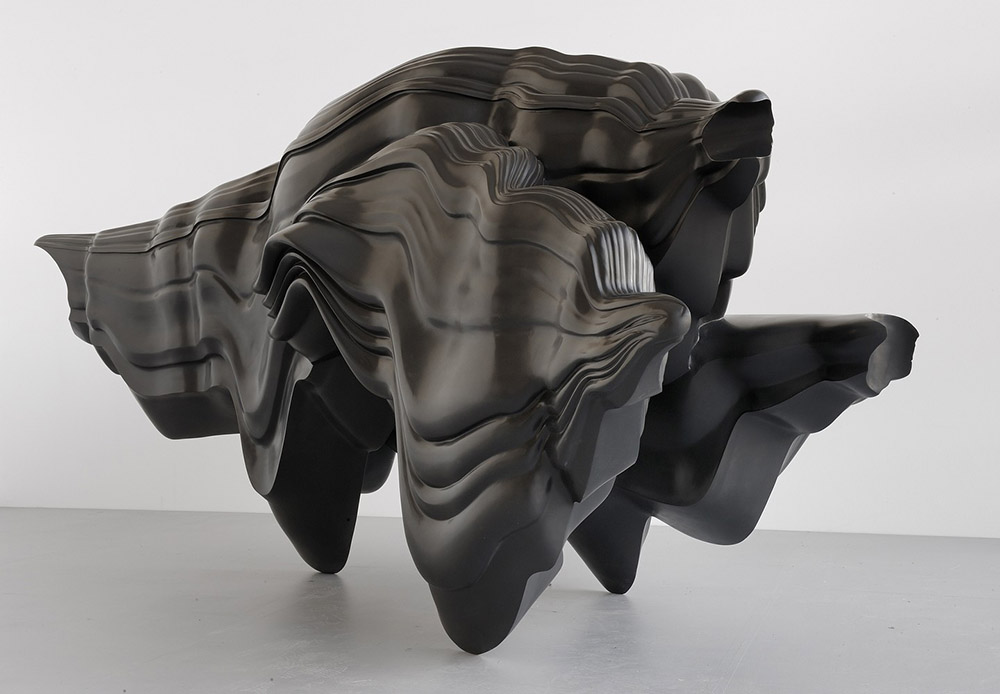ART-PRESENTATION: Tony Cragg-Endless Form
 Constantly pushing to find new relations between people and the material world, there is no limit to the materials Tony Cragg might use, as there are no limits to the ideas or forms he might conceive. His early, stacked works present a taxonomical understanding of the world, and he has said that he sees manmade objects as “fossilized keys to a past time which is our present”. So the floor and wall arrangements of objects that he started making in the 1980s blur the line between manmade and natural landscapes.
Constantly pushing to find new relations between people and the material world, there is no limit to the materials Tony Cragg might use, as there are no limits to the ideas or forms he might conceive. His early, stacked works present a taxonomical understanding of the world, and he has said that he sees manmade objects as “fossilized keys to a past time which is our present”. So the floor and wall arrangements of objects that he started making in the 1980s blur the line between manmade and natural landscapes.
By Efi Michalarou
Photo: Museo Nivola Archive
With Tony Cragg’s solo exhibition “Endless Form” the Museo Nivola, is continuing its exploration of sculpture as a tool for the investigation of space, comparison of form and materials, and as an artistic practice that can have a real impact on today’s culture and social dynamics. In a space flooded with light, Cragg’s monumental sculptures are in dialogue with each other, the architectural context, and the landscape that can be glimpsed through the arches of the large windows. Its volumes are at once both imposing and light, and as a result the works take firm possession of the space, without seeming static. On the contrary, they seem to be in a state of constant flux, following the inclination of the rays of light and the movements of the viewer around them. They are dynamic objects bearing the traces of the processes that created them, processes that first begin with drawings that are often figurative, and in encountering the material are guided by its internal force. As the artist has stated, “Even if it’s nothing linear, things generate something. There is a kind of self-propagating, self-generating energy within the material itself”. Cragg’s interest in material forms was informed by his experience as a laboratory assistant in 1966 at the National Rubber Producers’ Research Association in Hertfordshire. There, he was involved in experiments that compelled him to investigate the properties of matter, which opened his eyes to the possibilities of combining natural and synthetic elements – a new approach to sculpture. Cragg’s core skills as an artist came from his attendance at Gloucestershire College of Art in Cheltenham, where he studied drawing, painting, printmaking, ceramics and sculpture, and from his continued studies at Wimbledon College of Art and the Royal College of Art, where he received his Masters in Sculpture. Some of Cragg’s works seem to be the result of rotating movements, while others reveal the fruits of accumulation, and others still the product of cutting and twisting the material. Some develop vertically, in an apparent challenge to gravity like the wooden columns of “Pair” (2015) and the slim steel spiral of “Zimt” (2014), while others offer the eye an abundance of recesses and multiplications, like “Caught Dreaming” (2006) or form structures that can be permeated by the light and atmosphere in “Hedge” (2008). In general terms we tend to think of sculpture as pure form, mass, and volume. In Cragg’s work, however, the quality of the surface facture, its texture and hue are equally important. Variations in finish make similar forms seem totally different, rendering the skin of the sculpture warm or cool, smooth or rough, glossy or matte.
Info: Curators: Giuliana Altea and Antonella Camarda, Museo Nivola, Via Gonare n°2, Orani (Nu), Italy, Duration: 30/6-30/9/18, Days & Hours: Mon-Tue, Thu & Sun 10:3013:30 & 15:30-19:30, Fri-Sat 10:3013:30 & 15:30-20:00, www.museonivola.it

